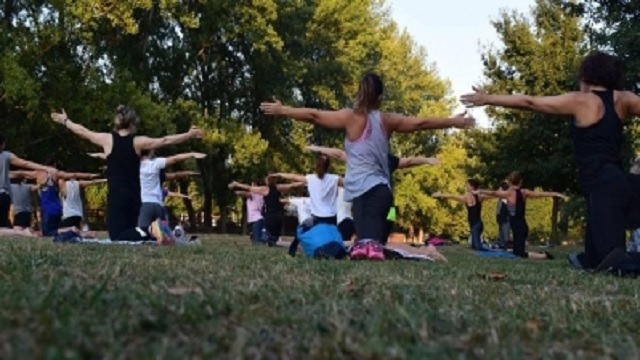Regular exercise, including aerobic activity and resistance training, offers diverse and substantial health benefits for people with type 2 diabetes.
Studies have shown that exercise promotes better blood sugar control and helps reduce excess body weight, two important risk factors for diabetes. Specific types of exercise can also help with health problems that older people with diabetes often experience, such as impaired balance and flexibility.
Other
The
Keep reading to learn more about type 2 diabetes and exercise, as well as other lifestyle practices that can help people manage the condition.
According to the American Diabetes Association (ADA), exercise is critically important for blood sugar management. Understanding how type 2 diabetes raises blood sugar clearly shows how physical activity can help.
The pancreas makes the hormone insulin, which allows cells to take up glucose from the blood to use it for energy. In people with type 2 diabetes, a problem called insulin resistance occurs and cells become less sensitive and reactive to insulin.
As a compensatory measure, the pancreas produces more insulin for the cells to respond. However, because the pancreas
Exercise helps counter the effects of type 2 diabetes in several ways. It increases insulin sensitivity, which helps cells use any available insulin to take up glucose from the blood. Additionally, when muscle cells contract during exercise, they are able to absorb glucose even when insulin is not available.
The blood sugar lowering effects of exercise last for up to about 24 hours after a workout.
While all exercise helps counter the effects of diabetes by promoting weight loss and increasing insulin sensitivity, the specific types below provide additional benefits:
- Aerobic exercise: Regular aerobic training lowers blood pressure, triglyceride levels, and A1C test results, which provide the average blood sugar for the past 2 to 3 months. Research has linked moderate to high-intensity aerobic exercise with significantly lower cardiovascular and overall death risks in people with diabetes.
- Resistance exercise: Diabetes is a risk factor for low muscle strength. Resistance training helps counter this effect, as it increases muscle mass and strength.
- Other types of exercises: Older people with diabetes tend to have limitations in balance and flexibility. Stretching exercises increase flexibility and range of motion, while balance training decreases the risk of falls and improves gait. Tai chi can improve balance, improve quality of life, and alleviate symptoms of diabetes that affect the nervous system.
Not exercising regularly robs a person of many health benefits.
Poor cardiovascular fitness
Not exercising leads to a decrease in cardiovascular condition, which can be a particular problem for people with diabetes because their risk of cardiovascular disease is two to four times higher than that of people without the disease. Several health conditions, including high blood pressure, high cholesterol and obesity, contribute to this increased risk.
Poor cardiovascular fitness is strongly correlated with an increased risk of death from all causes in people with diabetes.
High blood sugar
Without the effects of exercise, blood sugar remains higher than it would otherwise be. Studies link elevated A1C levels to complications of diabetes linked to damage to blood vessels. High blood sugar damages blood vessels in a way that
Exercise helps keep blood sugar at healthy levels. Healthy blood sugar prevents damage to blood vessels.
The
Here are some examples of moderate intensity exercise:
- walk briskly
- to mow the lawn
- ride a bike
- dancing
- to do the housework
- to swim
- play sports
Regardless of how much exercise a person does, research links sedentary behavior – which involves prolonged sitting, such as working at a desk or watching TV – to a higher risk of disease and illness. death, warns the ADA.
Studies also link sedentary behavior and poor blood sugar control in people at risk of developing type 2 diabetes. These people can improve their blood sugar levels by walking lightly or exercising. exercise for 3 minutes every 30 minutes.
Lifestyle habits are very beneficial in the management of type 2 diabetes. In addition to exercise, the
Eat a well-balanced diet
A well-balanced diet includes appropriate servings of nutritious foods and limits the consumption of non-nutritious foods. Nutritious foods include:
- whole grains, such as oats and brown rice
- fruits and vegetables
- non-fried fish rich in omega-3 fatty acids, such as salmon
- unsalted nuts, seeds, and legumes, such as beans
- lean meats, such as chicken or turkey breast
Foods to limit include:
- desserts and sugary drinks, such as cakes, candies, sodas and juices
- salty food
- fatty or processed meats, such as hot dogs, sausages, and fatty cuts of pork or beef
- partially hydrogenated and trans fats, such as shortening, coffee cream, and some hard margarines
Manage weight
Carrying excess weight makes it more difficult to manage blood sugar. A person can lose weight if they ingest fewer calories than they spend. Besides managing total body weight, it is important to lose excess belly fat, as a large waistline puts a person on
To manage stress
Stress can sometimes lead to overeating and smoking, which in turn can have a negative effect on blood sugar. Some anti-stress activities
- walking in nature
- meet a friend for coffee
- read a book
- listen to music
- practice a favorite sport
Stop smoking
Smoking increases blood sugar and increases the risk of complications from diabetes. It has such an effect that people who smoke have a
Certain herbs and supplements can also help improve blood sugar control in people with diabetes, although people shouldn’t use them in place of prescribed medical treatments.
Learn more about herbs and supplements for diabetes here.
Results from studies of type 2 diabetes and exercise indicate that workouts help increase insulin sensitivity, which promotes healthier blood sugar levels.
Additionally, resistance training reduces the decline in muscle strength associated with diabetes.
Aside from exercise, some other lifestyle practices are beneficial. These include eating a nutritious diet, managing body weight, stopping smoking, and taking steps to minimize stress.
 AD Roberts
AD Roberts



